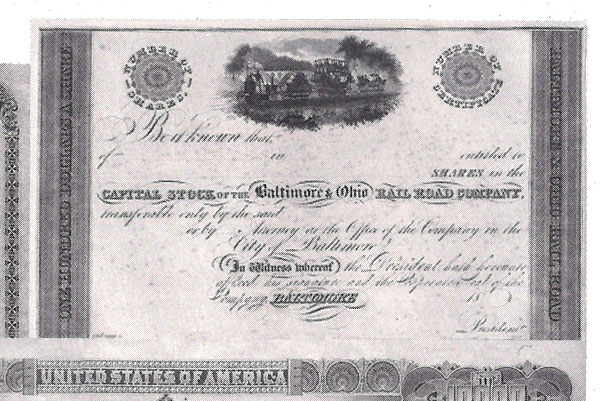Jim Fitzgerald of Fitzgerald Currency & Coins sent this email on August 29, 2015
Was advised to send you these images - I collect Texas
Civil War County Scrip, and alwasy interested in the paper that the printers
would scrounge up in order to complete an order - it "appears" this
two note sheet of 25 Cent notes is printed on the back portion of a Eastern
Texas Rail Road Company bond - as it was also payable in Nacogdoches.
I'll check with some other collectors to see if there notes
are also on the back of this company's bonds.
Nacogdoches County 25-cent fractional currency (note the bond image showing through from the back)
Note that the vignette and the text style are identical between the stock certificate and the bond fragment.
My reply:
While only "The Easte" is visible on this fragment, it is reasonable to conclude this item was part of a bond from the Eastern Texas Railroad Company. It turns out, however, the Mr. Fitzgerald had previously spotted an unattributed stock certificate from the company on a site titled "CSA Railroads", maintained by David Bright, at http://www.csa-railroads.com/Images.htm. (See below)
My reply:
Thanks for sending me images of both the fronts and backs of
these fractional notes from Nacogdoches County. Back when I sold paper money, I
used to see quite a few obsolete notes from southern states printed on the
backs of recycled bonds. Normally, it was hard to determine what the original
bonds might have been because it was rare to see more than a small part of a
bond at any one time.
This particular railroad company was incorporated in 1856 and
was sufficiently successful to have laid over 50 miles of track. The company
lasted until about 1863 when its equipment was raided to fortify Fort Sabine,
so I’m not entirely clear why its bonds were recycled into currency for
Nacogdoches County. Nonetheless, it was a common practice in the Civil War
South.
Followup for my readers:
Before we go any further, let me stress that:
- I have no conclusive evidence that any complete bonds for the Eastern Texas Railroad Company survive. At the present, we have no existing documents with which to compare this fragment.
- Records are not exact, but it is possible a bond from this company might reside in the collection of the Texas State Library and Archives Commission (box 4-3/442). If anyone has access and can check out this source, I'd appreciate knowing. (See http://www.lib.utexas.edu/taro/tslac/10220/10220-P.html.)
- Other than a passing reference in the source mentioned above, I can find no evidence that the Eastern Texas Railroad issued bonds. However...
- Few railroads could have been constructed from the proceeds of stock sales alone. It was a near-necessity for railroad companies, large or small, to borrow money by selling bonds.
- The majority of railroad companies seem to have issued bonds soon after incorporation.
Decent paper was in short supply practically everywhere across the Confederate states and grew worse as the Civil War wore on. It is extremely common to find obsolete currency printed on recycled documents of all types. Many of the notes of the time were uniface. Flip the notes over and you will often find evidence of invoices, receipts, stock certificates, bonds and, most commonly, other currency. Without a lot of work, it is usually impossible to identify the origin of the recycled documents.
In this case, it appears that Nacogdoches County needed to print fractional notes for local circulation because coins had all been hoarded after the outbreak of the Civil War. The County probably reached out to local businesses for any kind of usable paper and discovered that the railroad had a stash of bonds that it had been unable to sell.
Mr. Fitzgerald's example is HIGHLY unusual in that his uncut pair of 25-cent notes is large enough to be able for him to speculate about the company name on the original bonds. Look at the top image of the uncut pair of Nacogdoches notes and imagine if the two notes had been cut apart. There would have been NO possible way to identify the source of the printing on the other side!
I agree wholeheartedly with Mr. Fitzgerald's conclusion about the origin of the paper. Outside of the Eastern Texas Rail Road, I doubt there were any companies near Nacodoches large enough to attempt to sell corporate bonds.
In an attempt to learn more about its bond issues, I looked a little more into the company. It appears that my source of the company incorporation date was wrong. In my experience, finding wrong dates in railroad literature is the rule, not the exception. So, let me clarify with more research. Also, let me warn my readers that any and all derivative sources of date information are open to suspicion. Unless you are looking at original documents, you must suspect every date and every so-called "fact" you find.
According to the Texas State Historical Association (Handbook of Texas Online, https://tshaonline.org/handbook/online/articles/eqe04), the first incarnation of the company was the Henderson & Burkeville Railroad Company, chartered in 1852. That company changed its name to Mexican Gulf & Henderson Railroad Company in an 1856 charter amendment. The Eastern Texas Rail Road Company was chartered in January, 1860 and took over from the MG&H RR. The full text of the January 27, 1860 company charter appears in a section titled Special Laws of the Eighth Legislature Convened Nov. 7th, 1859 that appears in the General Laws of Texas.
Is the history of the company as clear as that? Of course not!
According to the Transactions of the Texas Academy of Science for 1906 (published 1907), the Eastern Texas Railroad was chartered in 1858. Support for that earlier date is partially substantiated by a 2-page document, dated Jul 26, 1858, at which time Texas Governor Hardin Richard Runnels appointed commissioners for the Eastern Texas Railroad Company. The earlier date is further referenced in the Analytical Index to the Laws of Texas (1906) under legislation named 4-1239-1858 that chartered the company in 1858. Nonetheless, I have been stymied to find more robust clarification of the 1858 charter through online research.
So with this meager information in hand, I will guess that the company would have tried to sell bonds after both the 1858 and 1860 incorporations.
My proof? None. So I will continue with my speculations.
There seems to be no evidence that the Eastern Texas Railroad (of 1858) laid any track in either 1858 or 1859, probably because of the lack of money.
On the other hand, we know from numerous sources that the company had laid 15 to 20 miles of track from Sabine Pass to Beaumont by 1861. Obviously, it had acquired money from somewhere.
It turns out that the State Gazette (Austin) reported in its July 7, 1860 issue that investors had already subscribed to $301,000 in stock, presumably issued by the 1860 version of the company. As I said earlier, companies could rarely lay track without borrowing substantial amounts of money through the issuance of bonds. Therefore, it seems probable the source of 1861 construction funds came from 1860 or 1861 bond sales.
In conclusion, if the company issued bonds in 1860 (or 1861) and they were still extant in 1861, there would have been no reason to recycle them into currency in 1862. It seems much more likely that Mr. Fitzgerald's Nacogdoches County notes were printed on recycled bonds that had been printed in 1858.
In this case, it appears that Nacogdoches County needed to print fractional notes for local circulation because coins had all been hoarded after the outbreak of the Civil War. The County probably reached out to local businesses for any kind of usable paper and discovered that the railroad had a stash of bonds that it had been unable to sell.
Mr. Fitzgerald's example is HIGHLY unusual in that his uncut pair of 25-cent notes is large enough to be able for him to speculate about the company name on the original bonds. Look at the top image of the uncut pair of Nacogdoches notes and imagine if the two notes had been cut apart. There would have been NO possible way to identify the source of the printing on the other side!
I agree wholeheartedly with Mr. Fitzgerald's conclusion about the origin of the paper. Outside of the Eastern Texas Rail Road, I doubt there were any companies near Nacodoches large enough to attempt to sell corporate bonds.
In an attempt to learn more about its bond issues, I looked a little more into the company. It appears that my source of the company incorporation date was wrong. In my experience, finding wrong dates in railroad literature is the rule, not the exception. So, let me clarify with more research. Also, let me warn my readers that any and all derivative sources of date information are open to suspicion. Unless you are looking at original documents, you must suspect every date and every so-called "fact" you find.
According to the Texas State Historical Association (Handbook of Texas Online, https://tshaonline.org/handbook/online/articles/eqe04), the first incarnation of the company was the Henderson & Burkeville Railroad Company, chartered in 1852. That company changed its name to Mexican Gulf & Henderson Railroad Company in an 1856 charter amendment. The Eastern Texas Rail Road Company was chartered in January, 1860 and took over from the MG&H RR. The full text of the January 27, 1860 company charter appears in a section titled Special Laws of the Eighth Legislature Convened Nov. 7th, 1859 that appears in the General Laws of Texas.
Is the history of the company as clear as that? Of course not!
According to the Transactions of the Texas Academy of Science for 1906 (published 1907), the Eastern Texas Railroad was chartered in 1858. Support for that earlier date is partially substantiated by a 2-page document, dated Jul 26, 1858, at which time Texas Governor Hardin Richard Runnels appointed commissioners for the Eastern Texas Railroad Company. The earlier date is further referenced in the Analytical Index to the Laws of Texas (1906) under legislation named 4-1239-1858 that chartered the company in 1858. Nonetheless, I have been stymied to find more robust clarification of the 1858 charter through online research.
So with this meager information in hand, I will guess that the company would have tried to sell bonds after both the 1858 and 1860 incorporations.
My proof? None. So I will continue with my speculations.
There seems to be no evidence that the Eastern Texas Railroad (of 1858) laid any track in either 1858 or 1859, probably because of the lack of money.
On the other hand, we know from numerous sources that the company had laid 15 to 20 miles of track from Sabine Pass to Beaumont by 1861. Obviously, it had acquired money from somewhere.
It turns out that the State Gazette (Austin) reported in its July 7, 1860 issue that investors had already subscribed to $301,000 in stock, presumably issued by the 1860 version of the company. As I said earlier, companies could rarely lay track without borrowing substantial amounts of money through the issuance of bonds. Therefore, it seems probable the source of 1861 construction funds came from 1860 or 1861 bond sales.
In conclusion, if the company issued bonds in 1860 (or 1861) and they were still extant in 1861, there would have been no reason to recycle them into currency in 1862. It seems much more likely that Mr. Fitzgerald's Nacogdoches County notes were printed on recycled bonds that had been printed in 1858.












